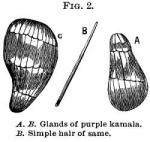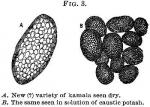BY WILLIAM KIRKBY, PH.C.
Related entries: Waras
Read before the Manchester Pharmaceutical Association.
Kamala was not known in Europe as a drug until a very recent period. Before the year 1852 the only account of it is in the writings of Anslie, Roxburgh, Royle and Buchanan. In that year, however, Port-Surgeon Vaughan met with it in the bazaar of Aden under the Arabic name of wars. Specimens obtained by him were forwarded to Mr. Daniel Hanbury, together with information concerning the same. The following information collected by him is found in his "Notes on Drugs observed at Aden, Arabia:" "Wurrus or warus is a red powder used chiefly as a dye. It is the produce of a plant resembling sesame. The plant rises to about 5 feet in height, bearing several separate bunches or clusters of small round seeds, which are covered with a description of flour; this, removed by gentle rubbing, constitutes the dye. Two kinds come into the market. The best comes from the interior, principally from the towns of O Badan and Gebia, and the districts of Yaffaee and Sjibul Rudfan. The second kind, brought by the Somalia of the opposite coast, conies from Hurrer. The second quality is not so much valued, and does not realize the price of the kind which comes from the interior. A considerable quantity of the dye is exported to Bombay, being used at Surat by ladies for dyeing silk a light brown-yellow. The Arabs use it as a dye and as a medicine, internally, for leprosy, and externally, in solution, for freckles and pustules. Much of it finds its way to the Persian Gulf, being known as asberg." Dr. Yauglian goes on to say that the best quality sells for 24 rupees the maund, while the African variety sells for only 17 or 18 rupees the maund.
Mr. Hanbury states that he showed the specimens he had received to Mr. Alexander Gibson, of Bombay, who was at that time in London. Mr. Gibson suggested to him that it was obtained from Rottlera tinctoria. He then proceeded to compare the drug with specimens in the museum of the Linnaean Society, and found that Mr. Gibson was correct in his surmise.
Kamala, as found in commerce, is a fine, mobile powder, of a dull red color. Under the microscope it is seen to consist chiefly of translucent, bright red granules mixed with colorless stellate hairs. These hairs give the drug its dull appearance.
![]() The glands, Fig. 1, B, are spherical, rather irregularly so. Their diameter is from 70 to 120 mkm. (micromillimetres). They are flattened on one side, and are composed of a number of clavate cells enclosed in a pale yellow membrane. The cells are arranged in a radiate manner round a short stalk cell, which is not always visible, occupying the basal side of the gland. From ten to thirty of these cells may be seen on one side; the whole cell, however, contains from twenty to sixty of them. The cells are filled with a red resin, which is soluble in solution of caustic potash, alcohol and ether. On treatment with solution of caustic potash the structure of the gland becomes plainly visible. On appropriate treatment, first with alcohol and afterwards with Schultz's solution of sulphuric acid and iodine, the cells are seen to be composed of cellulose, while the enclosing membrane is seen not to be cellulose.
The glands, Fig. 1, B, are spherical, rather irregularly so. Their diameter is from 70 to 120 mkm. (micromillimetres). They are flattened on one side, and are composed of a number of clavate cells enclosed in a pale yellow membrane. The cells are arranged in a radiate manner round a short stalk cell, which is not always visible, occupying the basal side of the gland. From ten to thirty of these cells may be seen on one side; the whole cell, however, contains from twenty to sixty of them. The cells are filled with a red resin, which is soluble in solution of caustic potash, alcohol and ether. On treatment with solution of caustic potash the structure of the gland becomes plainly visible. On appropriate treatment, first with alcohol and afterwards with Schultz's solution of sulphuric acid and iodine, the cells are seen to be composed of cellulose, while the enclosing membrane is seen not to be cellulose.
Professor Flückiger says that he examined authentic specimens from the Calcutta gardens. These were taken from Mallotus phillipinensis (Rottlera tinctoria), and he found them to agree entirely with the kamala of commerce.
From this it is plainly evident that the source of commercial kamala has been definitely settled.
Some years ago Messrs. Allen and Hanbury imported a remarkable kind of this drug from Aden. A full account will be found in "Pharmacographia." Mr. Hanbury forwarded a sample of this to Professor Flückiger, who submitted it to an exhaustive examination. It differs from the ordinary variety in bulk, in having a dark red or violet color. Microscopically examined, it is at once seen to have quite a distinct structure. Solution of caustic potash dissolves the resin contained by the glands and the general structure is easily seen.
The glands are cylindrical, somewhat conical, and are composed, like the other, of resin cells enclosed by a membrane. The arrangement of the cells will be best understood by reference to Fig. 2. The glands are 170 to 200 mkm. long and from 70 to 100 mkm. broad. The hairs mixed with them are simple and long, when compared with the short stellate hairs of the common kind. Professor Flückiger is quite sure the two kinds are not obtained from the same plant.
Dr. Dymock, in his "Vegetable Materia Medica of Western India," says: "'Wurs,' or 'wurrus,' which differs from genuine kamala in being a dark purple color, is the gland of the leaf of a leguminous plant, Flemingia Congesta." He was not able to ascertain if it is collected in India or whether it is imported from Arabia. I have not had the pleasure of seeing Dr. Dymock's book; but it was the note, as above, which appeared in "The Mouth" of a recent number of the "Pharmaceutical Journal," which first attracted my attention to kamala and its sources. Thinking it would be interesting to know if commercial kamala was entirely the produce of M. phillipinensis, I obtained samples of the drug from various parts of the country. I find that every one of the specimens obtained from dealers is genuine kamala.
Mr. E. M. Holmes, of the Pharmaceutical Society, has been kind enough to let me have samples of the specimens in the Society's museum. The results of my examination are as follows:
Sample marked "490 b," catalogued "Glands, covering fruit of Rottlera tinctoria," is genuine kamala.
Sample marked "490 c" catalogued "Wurrus, first quality," is identical with the purple variety examined by Professor Flückiger and is presumably the one referred by Dr. Dymock to Flemingia congesta.
Sample marked "490 d," catalogued "Wurrus, second quality." This is totally different from either of the other two varieties spoken of. I have been unable to find any record of a third kind of this drug. I therefore venture to put before you a short description of this specimen. The glands are from 50 to 170 mkm. long, and from 50 to 100 mkm. broad. When seen with the microscope in a dry state they are translucent and but faintly colored yellow. In form they vary very considerably; in fact, there appears to be no prevailing form. They impart but little color to ether, alcohol or solution of caustic potash. The cells are devoid of any such resin as is seen in the other two kinds. In solution of caustic potash they swell considerably, and their structure is rendered clearly visible. They consist of a mass of cells, composed of cellulose, enclosed by a non-cellulose membrane. The cells are not arranged in any particular manner. The general arrangement is shown, when seen in solution of potash, in Fig. 3, B. The hairs are similar to those found in the purple variety, being quite simple.
On drawing Mr. Holmes's attention to this unknown (?) variety, he informed me that he believed it was the second kind mentioned by Dr. Vaughan in his "Notes," and this sample was probably given by him to Mr. Hanbury, who presented it to the Museum.
I trust that some further information regarding the plants yielding the second and third varieties of "wurrus" will soon be forthcoming.
Looking at the last sort from an economic point of view, it would appear to be worthless as a dye, whatever it may be as a medicine.
In conclusion, I beg to tender my thanks to Mr. Holmes, and to Mr. Elborne who has assisted me in obtaining specimens of the drug.—Phar. Jour. and Trans., May 10, 1884, p. 897.
The American Journal of Pharmacy, Vol. 56, 1884, was edited by John M. Maisch.



